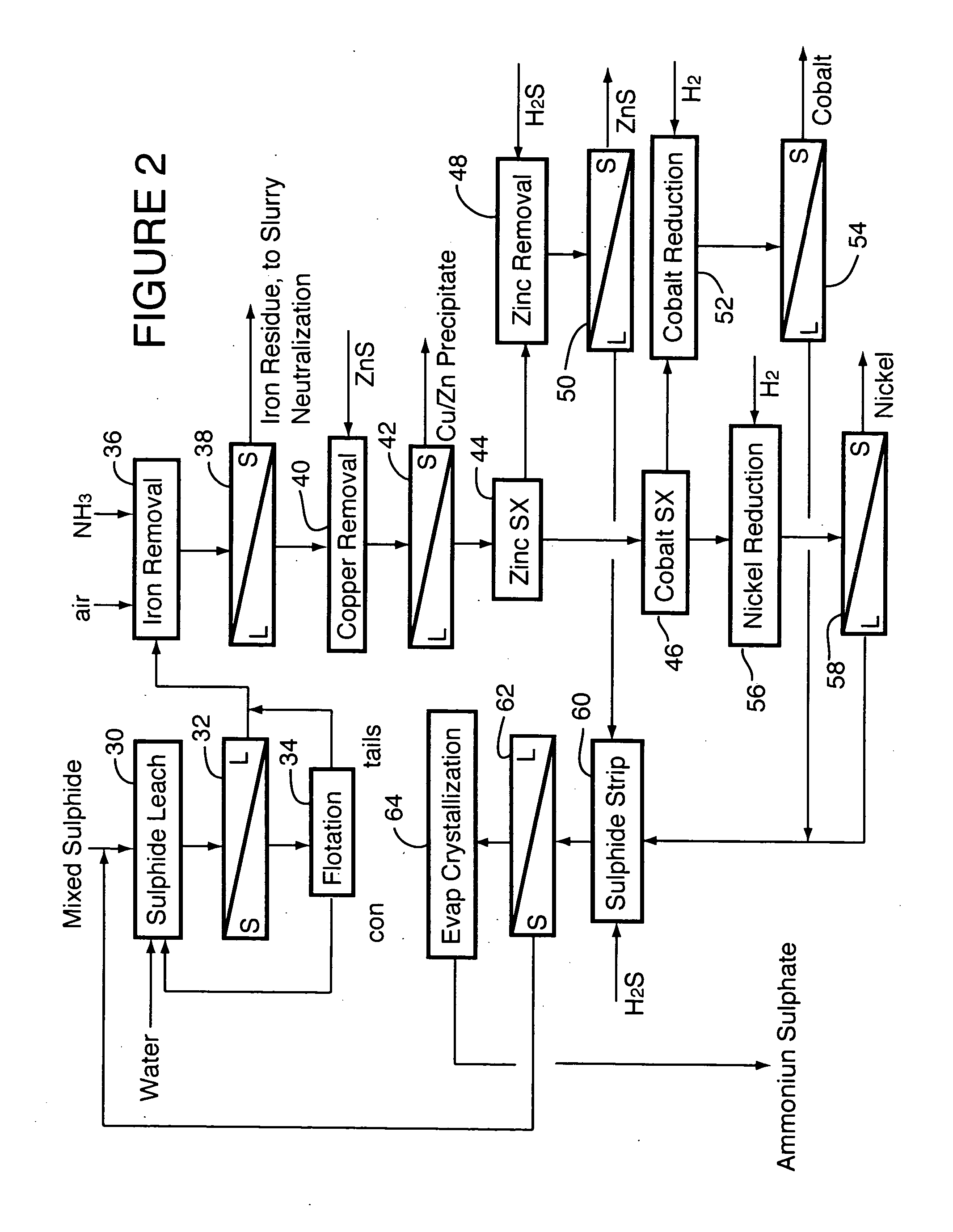Process for recovery of nickel and cobalt from laterite ore
a technology of laterite ore and nickel cobalt, which is applied in the field of recovery of nickel and cobalt from nickeland cobaltcontaining laterite ores, can solve the problems of large recirculating load of hydrogen sulphide, contaminating the mixed sulphide with these elements, and limiting the options for downstream processing of mixed sulphid
- Summary
- Abstract
- Description
- Claims
- Application Information
AI Technical Summary
Benefits of technology
Problems solved by technology
Method used
Image
Examples
example 1
[0036] The following example details the results of a nine-day continuous pilot plant campaign testing the flowsheet shown in FIG. 1.
[0037] Laterite ore containing (wt %): 1.13 to 1.29 Ni, 0.056 to 0.114 Co, 3.11 to 3.54 Al, 1.53 to 1.81 Cr, 46.2 to 49.2 Fe, 0.014 to 1.03 Mg, 0.51 to 0.83 Mn and 0.99 to 2.53 Si was fed to the first compartment of a continuous, multi-compartment horizontal autoclave of about 30 L operating volume. Sulphuric acid was separately fed to the same autoclave compartment, in sufficient quantity that the autoclave discharge solution contained at least 30 g / L free sulphuric acid, as measured at room temperature. This required addition of 0.22 to 0.30 tonnes of acid per tonne of ore solids. The retention time in the autoclave was between 70 and 80 minutes and it was operated at 260° C. Nickel extraction from the ore ranged from 95 to 97%; cobalt extraction was 93 to 97%. The autoclave discharge solution contained (g / L): 6 to 7 Ni, 0.35 to 0.55 Co, 4.8 to 6.2 ...
example 2
[0042] The mixed sulphide intermediate product described in Example 1 was processed in a single-compartment autoclave of 7.5 L operating volume to solubilize nickel and cobalt. The autoclave was operated in batch fashion owing to the small quantity of material to be processed. Test conditions were 165° C. and 500 kPa oxygen overpressure. Extractions were 99.0 to 99.3% for nickel and 98.3 to 98.8% for cobalt. The composite product solution contained (g / L): 95 Ni, 7.0 Co, 0.01 Al, 0.16 Cr, 0.78 Cu, 0.32 Fe, 0.01 Mg, 0.02 Mn, 0.05 Si, 9.0 H2SO4 and 2.7 Zn.
[0043] The residues from several of the leach tests were collected, and separately repulped in product liquor in a 2-L flotation cell to about 2 vol % solids. Air was applied and flotation was carried out at 60 to 70° C., without any additives, yielding 98 to 99% recovery of nickel and cobalt to the flotation concentrates.
[0044] The sulphide leach liquor was heated to 95° C. in an agitated, atmospheric tank and sparged with oxygen. ...
PUM
| Property | Measurement | Unit |
|---|---|---|
| Temperature | aaaaa | aaaaa |
| Temperature | aaaaa | aaaaa |
| Temperature | aaaaa | aaaaa |
Abstract
Description
Claims
Application Information
 Login to View More
Login to View More - R&D
- Intellectual Property
- Life Sciences
- Materials
- Tech Scout
- Unparalleled Data Quality
- Higher Quality Content
- 60% Fewer Hallucinations
Browse by: Latest US Patents, China's latest patents, Technical Efficacy Thesaurus, Application Domain, Technology Topic, Popular Technical Reports.
© 2025 PatSnap. All rights reserved.Legal|Privacy policy|Modern Slavery Act Transparency Statement|Sitemap|About US| Contact US: help@patsnap.com


